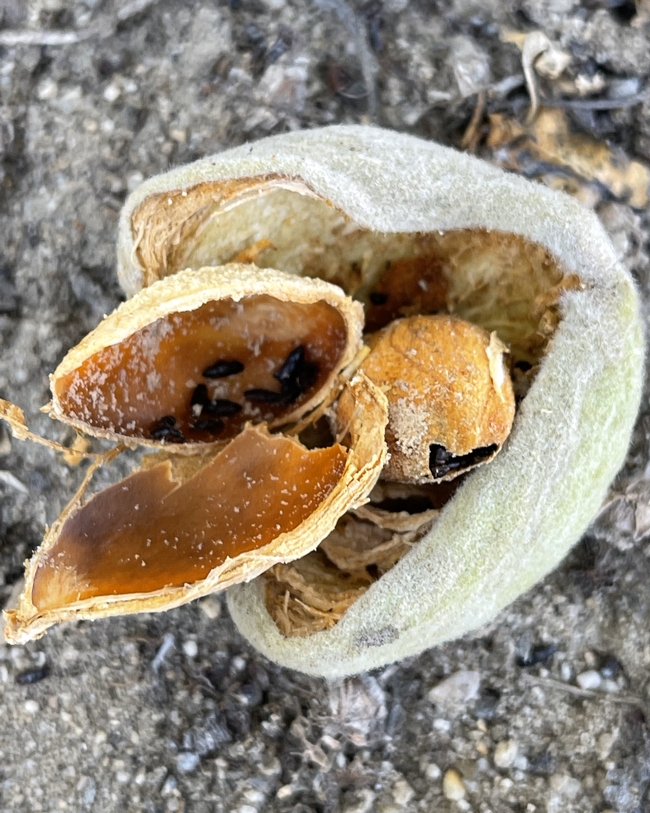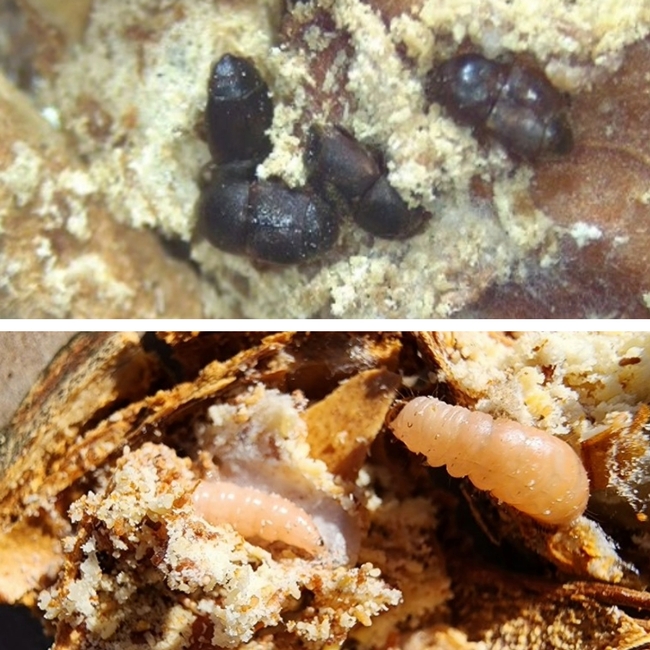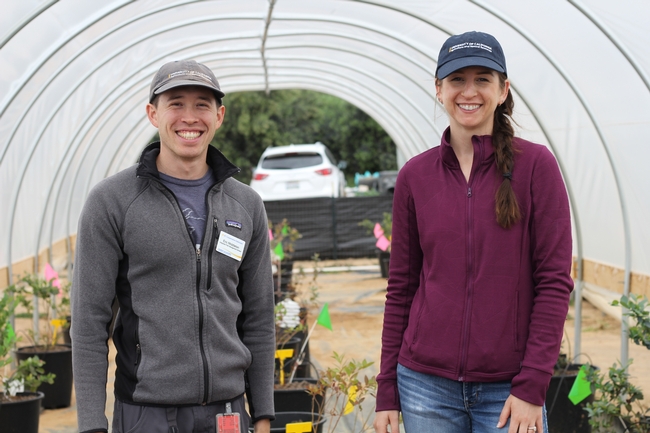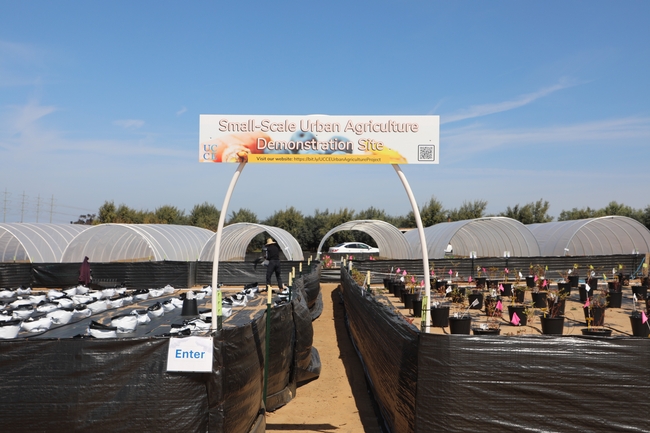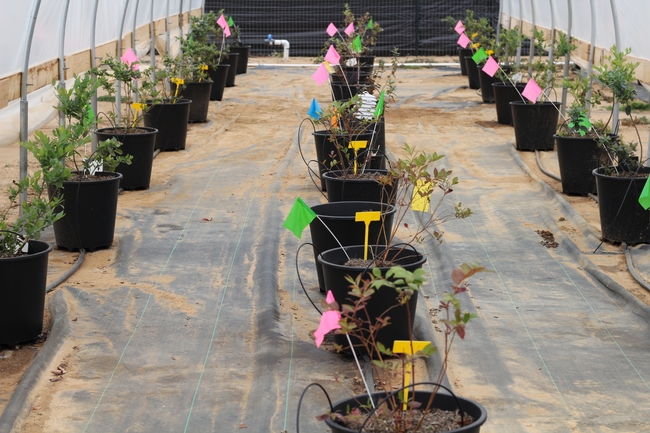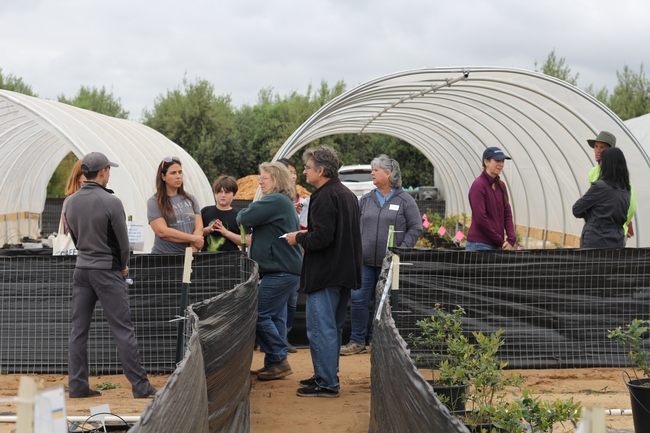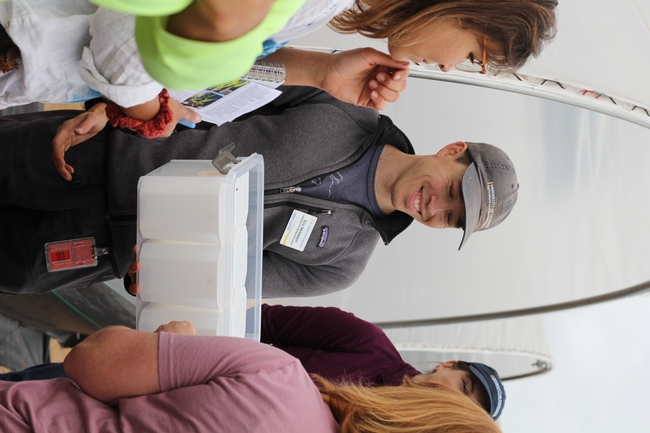Posts Tagged: Agriculture
Visual ID guide from UC aids in managing new almond pest
Nut orchard hygiene key to control carpophilus beetle, say UCCE, UC Integrated Pest Management experts
Since the first reports of a new almond pest – the carpophilus beetle (Carpophilus truncatus) – came in during fall 2023, it has become clear that the beetle is widely dispersed across the San Joaquin Valley.
“My lab has identified infestations from every county in the San Joaquin Valley; we have found infestations in both almonds and pistachios, and we will likely find infestations in walnuts this fall,” said Houston Wilson, a University of California Cooperative Extension entomology specialist at UC Riverside. The California Department of Food and Agriculture has confirmed the beetle's presence in Stanislaus, Merced, Madera and Kings counties.
Historically a major threat to almond production in Australia, the beetle – as larvae and adults – feeds directly on the nut kernel. In California, some almond growers have lost 10 to 15% of their yield – a “significant economic loss,” according to Jhalendra Rijal, University of California integrated pest management (IPM) advisor for the region. Given the prominence of almonds as a commodity, even a 1% overall reduction statewide represents an approximately $70 million loss.
“This year there has been a lot more reports from PCAs [pest control advisers]; they're sending me the pictures of the damage and beetles,” said Rijal, noting that the increase is likely due to greater awareness of the pest.
To help almond growers identify the carpophilus beetle and develop management plans, Rijal, Wilson and their IPM colleagues have put together a visual ID guide for the beetle and the damage it causes, as well as telltale signs of navel orangeworm (Amyelois transitella) and ant damage. In particular, the experts would like PCAs and growers to differentiate between the carpophilus beetle and navel orangeworm, another key pest in almonds.
“Even though their way of causing damage looks more or less similar, we're dealing with two different types of insects,” Rijal explained. “One is a Lepidoptera moth [navel orangeworm], and the other one is a beetle – many of the management practices and biological controls would be different for these two different things.”
To control carpophilus beetle, ‘sanitize, sanitize, sanitize'
One crucial cultural practice for managing both pests, however, is destroying the remnant “mummy” nuts – the nuts that remain in the orchard postharvest. They serve as overwintering habitat for the carpophilus beetle, as well as its sustenance for the next generation of beetles in spring.
“The best way to manage this pest is to do the orchard hygiene – continuing the winter sanitation, destroying the nuts that are on the ground and on the tree and on the berms,” Rijal said.
Based on observations in Australia and locally, carpophilus beetles tend to rely more on mummies on the ground, whereas navel orangeworm generally favors mummies in the tree canopy. Correctly identifying the pest – with help from the new ID guide – enables growers to better target and prioritize their management efforts, Rijal said.
“What we are strongly emphasizing is that growers need to sanitize, sanitize, sanitize to control both pests,” Wilson added.
Correct identification of the pest would also prevent unnecessary application of insecticides, as those used for controlling Lepidoptera such as navel orangeworm would be largely ineffective on the beetle.
Indeed, another insight shared by Australian experts is that the carpophilus beetle cannot be controlled just by insecticide.
“Insecticides are not very efficient, given the cryptic nature of these beetles; exposing these beetles to the insecticide is very hard,” said Rijal, noting that the beetle spends most of its life cycle protected inside the nut.
Reporting carpophilus beetle infestation helps researchers
This harvest season, Rijal advises almond growers to harvest as efficiently as possible, to minimize the number of mummies that need to be cleaned up. And because signs of damage (like damaged hulls and frass) are most obvious during harvest time, Rijal said growers should review the new guide, using the photos and other resources to help identify potential pests.
If the grower or PCA suspects a carpophilus beetle infestation, they should contact the UCCE farm advisor in their area.
Scientists are looking to expand their knowledge about this relatively new pest to California. In the coming weeks, for example, researchers are planning to survey for the carpophilus beetle in the Sacramento Valley.
“Technically it has not been found there, but we suspect that we'll find it this fall when we go looking for it,” Wilson said.
Researchers are also collecting samples from infested orchards to better understand the biology of the species, as well as how it progresses through and responds to seasonal and climactic changes. In addition, they are analyzing data from a trial study of an insecticide that might be used as a supplemental control measure.
“This is our first full season dealing with this insect, and there are still many things we need to understand,” Rijal said. “We are continuing our research efforts on all fronts.”
Hands-on learning, training make irrigation best practices accessible
UCCE advisors provide free training to nursery and greenhouse staff
Working as an irrigator seems straightforward at first: if you're not watering plants by hand, you're building and managing systems that can do the watering. What could be complex about a job like this?
University of California Cooperative Extension advisors Bruno Pitton and Gerardo “Gerry” Spinelli can tell you – or better yet, show you.
Pitton and Spinelli, members of the UC Nursery and Floriculture Alliance, offer a one-day technical training in irrigation best-management practices for irrigators working with containerized nursery plants. The comprehensive curriculum – developed with input from two focus groups of California nursery and greenhouse managers – aims to improve irrigation efficiency, reduce water consumption and improve plant health.
Thanks to funding from the California Department of Food and Agriculture, nursery and greenhouse managers in California can request this training for free and advisors like Pitton and Spinelli will travel to conduct the training on-site.
The complexities of irrigation incorporate concepts like evapotranspiration, salinity, irrigation uniformity, capillarity, pressure and flow rate. Spinelli, UCCE production horticulture advisor for San Diego County, said that irrigators have a critical role in the industry because of all the things they must consider to do their job well.
“Our goal is to support irrigators and help them become more confident decision-makers and experts in the field,” said Pitton, UCCE environmental horticulture advisor for Placer and Nevada counties.
Interactive sessions reveal nuances of irrigation
The training consists of a presentation on fundamental concepts for managing irrigation in container plant production and hands-on demonstrations. “In the nursery industry, where precise irrigation is crucial for the health and productivity of our crops, having access to expert knowledge is invaluable,” said Mauricio de Almeida, general manager of Burchell Nursery in Fresno County. “The training's practical demonstrations and real-world examples made the concepts easy to grasp, allowing our team to implement the strategies immediately.”
For one of the demonstrations, the advisors used sponges to model soil saturation when water is applied. Ana, an irrigator at Burchell Nursery, appreciated the step-by-step explanations, which helped her better understand how water pressure differs in drip irrigation, sprinklers and watering by hand. Doing this out in the field, as an example of how irrigation audits occur, was extremely helpful for attendees.
Francisco “Frank” Anguiano, production manager of Boething Treeland Farms in Ventura County, observed his team of irrigators as they learned how to measure distribution uniformity with water collected from sprinklers. “This training isn't just about irrigation and plant management. It's also about savings, both water and costs. Who doesn't want to save money and use less water?” Anguiano said.
Reducing the barriers to learning
Many of the irrigators attending these trainings gained their skills and knowledge from life experience rather than a college education, explained Peter van Horenbeeck, vice president of Boething Treeland Farms. “It's important that my irrigators learn from external experts, but it's more important that they can relate to them. And that's what Gerry was able to do,” van Horenbeeck added.
Regarding content and delivery, and referencing what he learned from the focus groups, Pitton wanted the trainings to be easy to understand and engaging. For example, scientists use the term “matric potential” to describe how soil particles hold water against gravity, which is the same as capillary rise. “We demonstrate this concept with a paper towel held vertically and dipped into a beaker of dyed water that it absorbs,” said Pitton.
Many of the irrigators in attendance agreed that hands-on activities and visual aids were instrumental to their learning. Charli, another irrigator at Burchell Nursery, shared that the in-field examples and hosting the training in Spanish kept them engaged.To address language barriers, Spinelli has been conducting trainings in Spanish – a common request from many nurseries with eager participants.
Maintaining state regulations and partnerships
Although the technical aspects of irrigation management are key elements of the training, regulatory compliance is also addressed. Recognizing the finite availability of water and the environmental impact of pollution, the advisors highlight irrigation and fertilizer management and runoff prevention as critical components of compliance.
Under Ag Order 4.0 administered by California's Water Resources Control Board, growers must comply with stricter policies regulating nitrogen use. As irrigators learn from the training, better control of irrigation can certainly make a difference.
Deanna van Klaveren, chief operating officer and co-owner of Generation Growers in Stanislaus County, said the most valuable aspect of the training was learning on-site and completing an audit on her own systems. “It is so much more impactful to have trainings like this on-site where our staff can learn and then go out into the nursery and actually put it into practice while the presenters/experts are there,” van Klaveren said.
Pitton and Spinelli described the partnership between UC Cooperative Extension and CDFA as “symbiotic” given the technical and educational capacity of UCCE advisors who conduct research and extension.
“It's a great example of how the two institutions can collaborate successfully. Californians are the ones who win because they get a service for free,” added Spinelli. “And it's rewarding for us to see so much interest in what we, as advisors, do.”
If you are a nursery or greenhouse operator and would like to request the Irrigation Best Management Practices training, please contact the UCCE advisor assigned to the region that corresponds with your nursery location below.
Northern California
- Jessie Godfrey, UCCE environmental horticulture and water resources management advisor, jmgodfrey@ucanr.edu
Central Coast (Santa Cruz County to Ventura County)
- Emma Volk, UCCE production horticulture advisor, evolk@ucanr.edu
San Joaquin Valley
- Chris Shogren, UCCE environmental horticulture advisor, cjshogren@ucanr.edu
Southern California
- Grant Johnson, UCCE urban agriculture technology advisor, gejohnson@ucanr.edu
Spanish Trainings Only
- Gerry Spinelli, UCCE production horticulture advisor, gspinelli@ucanr.edu
UCCE offers water measurement training Sept. 13 in Salinas
California water-rights holders are required by state law to measure and report the water they divert from surface streams. For people who wish to take the water measurements themselves, the University of California Cooperative Extension is offering in-person training to receive certification on Sept. 13 in Salinas.
At the workshop, participants can expect to
- clarify reporting requirements for ranches.
- understand what meters are appropriate for different situations.
- learn how to determine measurement equipment accuracy.
- develop an understanding of measurement weirs.
- learn how to calculate and report volume from flow data.
The training is scheduled for 1 to 5 p.m. on Sept. 13 in the UC Cooperative Extension Conference Room at 1432 Abbott Street in Salinas.
“We are limiting the number participants for the water measurement training to 30 people per session,” said Larry Forero, emeritus UC Cooperative Extension livestock and natural resources advisor. “If you need this training, please register soon.”
Pre-registration is required and the fee is $30. To register, visit https://surveys.ucanr.edu/survey.cfm?surveynumber=43495. If you have questions, email Forero at lcforero@ucanr.edu or Sara Jaimes at sbjaimes@ucanr.edu, or call (530) 224-4900.
Could empty lots be growing food, economic opportunity?
UCCE scientists study feasibility of specialty crops for small urban growers
The vacant lots around your neighborhood could be growing fruits and vegetables and making local produce more accessible – while reducing energy needed to transport and distribute the food. Could turning those empty lots into small farms also become opportunities for economic development?
To answer this question, a team of researchers from University of California Cooperative Extension in San Diego County are investigating the economic feasibility of growing high-value specialty crops in urban settings like vacant lots. The project – led by Eric Middleton, UCCE integrated pest management advisor for San Diego, Orange and Los Angeles counties – is currently in progress at The Flower Fields in Carlsbad, a seasonal attraction for locals and tourists.
Tucked away in the back of the field is the Small-Scale Urban Ag Demonstration Site where Middleton and his team established a small farm on approximately 17,000 square feet, starting fall 2023. Funded by the U.S. Department of Agriculture National Institute of Food and Agriculture, the farm is designed to evaluate containerized production both outdoors and under high tunnels.
Growers don't necessarily need land, just space
High tunnels, also referred to as hoop houses, are semi-permanent structures that act similarly to greenhouses in providing a controlled environment. For the experiment, Middleton will compare cost, effort and durability of two types of high tunnels: one made of steel and the other out of PVC pipes.
“We want to give interested growers information on as many options as we can,” said Middleton, who explained that the project is motivated by the challenges of urban settings, including limited space and lack of arable land.
In the trial, they are growing turmeric, ginger and blueberries. The high-value crops were selected because of their potential to earn a profit. Data evaluating plant variety, soil mix, fertilizer, growth performance, yield and pest and disease pressures will be collected and reported when the project concludes in 2026.
As the crops develop in containers – blueberries in pots and turmeric and ginger in grow bags – Middleton pointed out the mobility aspect of the study, noting that growers don't necessarily need land, just space.
Whether it's a backyard or a rooftop, containerized production means easier transport, especially since vacant land doesn't always remain vacant forever and urban lots may often need soil remediation. Growing in containers solves the anticipated problem of having to relocate.
Where to set up shop in San Diego County
Jan Gonzales, project coordinator and community education supervisor for UCCE San Diego County, is leading the effort to identify available urban land in San Diego County as well as the policies and procedures for growers to access these spaces.
Gonzales is collaborating with community members who are working on similar projects to identify space for prospective growers.
“This has been done before for different objectives and for specific areas in the region, but the information was either project-specific and not publicly available, or not easy to find,” Gonzales said.
Having spoken with people associated with previous or ongoing agricultural land mapping projects, Gonzales has agreed to coordinate and facilitate an advisory work group to discuss areas of potential collaboration and develop project efficiencies. She anticipates holding the first group meeting before the end of the summer.
A production guide to help community members re-create the project
The ideal audience for a study like this is anyone who wants to grow specialty crops, according to Lindsey Pedroncelli, interim director of UC South Coast Research and Extension Center in Irvine, who worked on the project alongside Middleton when she was a staff research associate with UCCE San Diego.
“If you're a new grower or a grower who wants to diversify your crop production, what we're learning here can be applied to you,” said Pedroncelli.
Pedroncelli has been instrumental in bringing the experiment to life and documenting its step-by-step workflow thus far. The production guide, which is being created as the study unfolds, will include instructions detailing how to replicate the experiment from the ground up. Currently, it contains information on how to design your farm, the materials to buy, building structures, irrigation setup and crop management.
The most intriguing open question, whether the operation is profitable, is the driving force behind the production guide and will certainly be addressed, Pedroncelli said.
Book a tour and visit the farm
When visiting the farm, you'll encounter three varieties of blueberries: Star, Snowchaser and Misty. Snowchaser has been a top producer since it was planted in January, but the variety is known to be an early season producer.
Using only one variety of each, the turmeric and ginger were planted in late March-early April. With some unanticipated cold weather in San Diego County, both crops struggled when transitioning out of dormancy, leading to very slow progress, which the team is still navigating today.
Visually, Middleton and his team have noticed differences between the crops growing under the high tunnels versus those grown outdoors, although the data has not been analyzed to confirm or explain notable differences.
Attempting to demonstrate how to profitably grow high-value crops in urban settings using limited space and resources, Pedroncelli said she hopes this study will also encourage people to grow culturally significant crops for their communities.
To tour the Small-Scale Urban Ag Demonstration Site at The Flower Fields in Carlsbad, email Eric Middleton at egmiddleton@ucanr.edu with "Urban Agriculture Demonstration Site Tour" in the subject line.
To learn more about the project and its progress, visit https://ucanr.edu/sites/socalIPM/Small_Scale_Urban_Agriculture_Project_/.
ANR hires expertise in urban pests, plants and small farms
From Siskiyou County through Riverside County, University of California Agriculture and Natural Resources has hired UC Cooperative Extension experts to help Californians address challenging issues.
The eight recently hired UC Cooperative Extension specialists, advisors and coordinators bring expertise in urban pest management, healthy families, regenerative agriculture, plant science, small farms and food safety to their communities.
Since 1914, UC Cooperative Extension researchers have been working directly with community members to improve their lives and livelihoods.
To see a list of UC Cooperative Extension experts who have joined in the past few months, visit https://ucanr.edu/About/DirectorySearch/Recent_Hires. The most recently hired scientists are introduced below.
Lee brings expertise in urban pest behavior to Capitol Corridor IPM role
Sang-Bin Lee joined UC ANR as the urban integrated pest management advisor for the Capitol Corridor – comprising Sacramento, Yolo and Solano counties – to help communities manage urban pests such as cockroaches, termites and ants.
“My high-level hope is to improve public health and the well-being of people in the Capitol Corridor region by implementing and improving the IPM program,” Lee said.
A native of South Korea, Lee earned his bachelor's in biology from Pusan National University. After working in the food manufacturing sector (which included a stint in Brazil, where he learned basic Portuguese), Lee decided to pursue his passion for studying animal behaviors. During his master's program in ecology at Pusan National University, Lee investigated behavioral changes in zebrafish after pathogen infection.
“My goal was to detect fish with symptoms much earlier than conventional methods to prevent the spread of pathogens in fish farms,” he said.
Intrigued by research on social insects, Lee went on to earn a Ph.D. in entomology from the University of Florida, where he studied the social behaviors of termites. Lee has published 34 peer-reviewed articles in professional journals and has received several awards from Entomological Society of America and other professional societies.
He said that he finds urban pest management to be a fascinating discipline – and a very rewarding endeavor – in the field of entomology.
“My interests lie in the behavior of urban pests, and studying their behavior often provides a great opportunity to improve control measures,” Lee explained. “I have had many opportunities to communicate with people from the pest control industry and homeowners; conversations with these people often inspire me to work harder to help those who need my assistance.”
Lee is based in Fairfield, at the UC Cooperative Extension office in Solano County, and can be reached at sablee@ucanr.edu and (530) 574-9835. He is on X/Twitter @SangBinLee4.
New farm advisor Singh to bring latest research to Siskiyou County 
Jagdeep Singh recently joined UC ANR as the agronomy advisor for Siskiyou County. In this capacity, Singh will primarily focus on crop production in alfalfa, pasture and small grains, as well as pest control and water management.
Originally from Punjab, India's agriculture-rich state, Singh brings a unique perspective to his work.
“My passion lies in directly impacting the lives of farmers who feed the world,” he said. “I'm driven by a constant thirst for knowledge and a commitment to bridging the gap between the most up-to-date research and practical, on-farm solutions. What motivates me is understanding farmers' needs and providing science-based answers to their questions.”
Singh earned a B.S. from Punjab Agricultural University, an M.S. from New Mexico State University, and a Ph.D. from Auburn University.
During his Ph.D. studies, he assessed 70 years of cotton breeding impacts on yield, nutrient relations and root architecture, while also studying cover crops for soil health improvement. His M.S. work focused on guar, evaluating its growth, yield, water extraction patterns and water use efficiency under deficit irrigation, as well as identifying cold-tolerant germplasm for cooler regions of the Southern High Plains.
In his new role at UC ANR, Singh aims to build strong relationships with the local community, certified crop advisers and industry groups, leveraging the well-established extension system.
Singh can be reached by email at fgssingh@ucanr.edu or by calling the UCCE Siskiyou office at (530) 842-2711.
Rosenberg joins UCCE as regenerative agriculture farm advisor 
Sara Rosenberg joined UCCE as a regenerative agriculture farm advisor for Mariposa, Merced and Stanislaus counties.
Her disciplinary focuses are agroecology, sustainable nutrient management, and extension research and methodology. Her past research centers on understanding the implications of diversification (with a focus on crop rotations and cover crops) for California rice systems. For her master's program thesis, she conducted a countywide assessment to learn from rice growers about their experiences with crop rotations and understand barriers to adoption, opportunities, and required resources for successful implementation. This two-year study engaged grower communities to help develop research goals for her Ph.D. studies.
Her doctoral research explored how different summer crop rotations affect multiple sustainability factors including soil health, crop yields, weeds, input use and economics. She also assessed different cover-crop species performance in rice environments and their carbon and nitrogen contributions.
She earned a master's in international agriculture development and a Ph.D. in horticulture and agronomy from UC Davis.
Prior to working on her Ph.D., Rosenberg was an agriculture advisor in the Peace Corps for more than three years. She worked closely with smallholder farmers in West Africa, implementing conservation agriculture programs and increasing agricultural resilience in both annual crops and tree crops, mainly in the cashew forestry sector. In California, she has worked on farms for more than eight years, including running her own small, diversified farm in Woodland.
She is passionate about community-led development and using participatory research as a powerful tool for developing sustainable solutions. Her aim is to develop collaborative programming that will support a wide range of farm types, including commercial and small-scale, organic and conventional, annual crops, tree and vine crops, and livestock production systems.
She is developing a robust research program aimed at assessing farm sustainability impact across ecological, agronomic, social and economic factors. She will be collaborating with farmers to help overcome barriers to adopting regenerative practices and build their capacity to advance sustainability goals. Rosenberg also will be developing and promoting tested integrative management practices that increase climate resilience and ecosystem sustainability across diverse farming environments.
Rosenberg is based in Mariposa and can be reached at srosenberg@ucanr.edu and (209) 966-2417 ext. 1417.
Sangha joins UCCE as community water systems advisor 
Laljeet Sangha joined UCCE as a community water systems advisor for Kern, Tulare and Kings counties.
To enhance community resilience, Sangha will lead an integrated extension education and applied research program in water resource management and community development.
He will address critical questions regarding the impacts of environmental stressors, such as chronic long-term droughts, water contamination and increased groundwater demand. Additionally, he will assist in water system consolidations and help communities meet regulatory goals such as those set by the Sustainable Groundwater Management Act (SGMA) and the Irrigated Lands Regulatory Program (ILRP).
Originally from Punjab, India, Sangha earned his undergraduate degree in agricultural engineering from Punjab Agricultural University. He received his M.S. in biosystems engineering from Auburn University and his Ph.D. in biological systems engineering at Virginia Tech.
Sangha's early research focused on the influence of climate variability on ecologically sustainable water withdrawals from streams for irrigation. For his doctoral studies, he evaluated the impact of permit exemptions, climate change and demand growth on water supply. Additionally, he developed methods to quantify unreported water use for crop irrigation.
Sangha also has collaborated on projects in the Colorado River Basin, which explore why the Colorado River no longer reaches the sea. His work includes evaluating the effects of limited water availability on irrigation operations and developing adaptive options for farming communities in the basin.
Sangha is based in Bakersfield and can be reached at lsangha@ucanr.edu.
Beveridge joins ANR's Small Farms team 
Claire Beveridge joined UC ANR as a small farms water-conservation academic coordinator for Fresno, Tulare and Madera counties. She is also part of the statewide UC Sustainable Agriculture Research and Education Program, or SAREP.
As an academic coordinator, Beveridge supports small-scale, diversified and socially disadvantaged farmers in Fresno and surrounding areas in on-farm water conservation through education, technical assistance, outreach and research activities. This encompasses aiding farmers with improved irrigation practices and technologies, groundwater regulation compliance and on-farm groundwater recharge.
She also facilitates small-scale farmer access to state incentives for water and energy efficiency, as well as drought and flood relief programs. Beveridge also helps to inform state water policy on the unique needs of small-scale farms.
She is broadly interested in fostering sustainable water resource management through interdisciplinary and collaborative approaches among communities, decisionmakers and researchers.
Beveridge holds a Ph.D. in civil and environmental engineering with an emphasis in hydrology from the University of Washington. She conducted postdoctoral research at Florida International University and earned her bachelor's degree in civil and environmental engineering from UC Berkeley. She is a licensed Professional Civil Engineer in California, an inaugural editor of the Community Science Exchange journal and resource hub, and recently completed a USDA International Agriculture Education Fellowship in Uganda.
“I grew up in Madera and am excited to be serving my home region as part of UC ANR,” she said.
Beveridge is based in Fresno and can be reached at cbeveridge@ucanr.edu.
Pourkhalili to promote healthy families and communities 
Azin Pourkhalili joined UCCE as a youth, family and community advisor for Kern, Inyo and Mono counties.
In her role, she will promote healthy families and communities by designing, delivering and evaluating strategies for encouraging nutrition and physical activity in youth and their families. Additionally, she will provide academic oversight of community education and outreach program staff who work with families and youth, including the UC 4-H Youth Development Program, CalFresh Healthy Living UC Nutrition Education Program, Expanded Food Nutrition Education Program (EFNEP) and Juntos.
Pourkhalili brings over six years of experience in conducting health intervention research programs, including their development, implementation and evaluation.
Before moving to California, Pourkhalili was a Virginia Cooperative Extension research scientist. She worked on multiple health intervention projects, including nutrition education for older adults through the Elder Nutrition and Food Safety program and the prevention and management of chronic diseases through programs such as the Lifestyle Change Program, Diabetes Prevention Program, Balance Living with Diabetes, and Kick'n Cancer. She also collaborated with the Virginia Department of Health on various projects.
Pourkhalili's academic background encompasses the latest research in nutrition and physical activity education programs, chronic disease prevention programs and health education programs for different age groups. Building on her experience in implementing and evaluating nutrition education programs, her future research aims to address the unique health education needs of diverse communities in California. She plans to continue researching the evaluation and effectiveness of health education programs, such as CalFresh Healthy Living UC, EFNEP and 4-H.
She holds a Ph.D. in human nutrition, food and exercise, specializing in community and behavioral science, and a graduate certificate in gerontology from Virginia Tech.
Pourkhalili is based in Bakersfield and can be reached at apourkhalili@ucanr.edu.
Atume to provide small farms SGMA technical assistance 
Ngodoo Atume joined UC ANR as a Sustainable Groundwater Management Act small farms technical assistance coordinator in the Sustainable Agriculture Research and Education Program.
She will provide technical information, services, policy analysis and recommendations needed to engage and protect small-scale farmers in the implementation of the Sustainable Groundwater Management Act (SGMA).
Before joining UC ANR, Atume worked as a water policy analyst advocating for the implementation of the Human Right to Water in California. She also worked on the inclusion of underrepresented stakeholders in SGMA, Central Valley Salinity Alternative Long-Term Sustainability (CV-SALTS) and the Irrigated Lands Regulatory Program (ILRP).
Born and raised in Nigeria, Atume earned her bachelor's degree in water resources and environmental engineering at Ahmadu Bello University, where her research focused on the treatment and reuse of wastewater. She has a master's degree in sustainable water management from Tufts University.
Atume is based at the UC ANR office in Davis and can be reached at natume@ucanr.edu.
Fujiyoshi joins Capitol Corridor small farms team 
Phillip Fujiyoshi joined UCCE small farms team in the Capitol Corridor as an extension and research associate. Working with Margaret Lloyd, UCCE small farms advisor, Fujiyoshi supports underserved farmers in Yolo, Sacramento and Solano counties by providing them with financial and agronomic technical assistance and making extension materials available in Spanish.
Born and raised in Santa Maria, Fujiyoshi earned his bachelor's degree in biology at the Massachusetts Institute of Technology. His academic knowledge of Spanish transformed into bilingual proficiency thanks to his life experiences of living with Spanish roommates, participating in a tree-planting brigade in Nicaragua and setting up a Spanish-speaking household with a Nicaraguan partner. The Nicaragua trip also sparked his lasting interest in agriculture, leading him into doctoral studies in agroecology at UC Santa Cruz.
After completing his Ph.D., Fujiyoshi performed molecular assays, contributed to phylogenetic studies, and led a spore-trapping field study in a lab studying grapevine trunk diseases. In addition, he pursued outside interests in agriculture, including winning an individual grant to study cabbage aphid behavior, pursuing informal cover crop trials in a community garden plot, volunteering on the UC Davis Student Farm, and giving agronomic advice to growers at the farmers market.
Fujiyoshi is based in Woodland and can be reached at (530) 666-8143 and pfujiyoshi@ucanr.edu.
